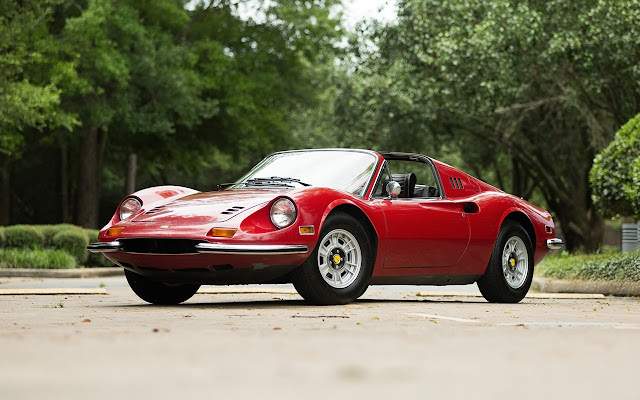1972 Ferrari Dino 246 GTS
- 2016 Ferrari Club of America National Preservation Award Winner
- 2016 Ferrari Club of America Preservation Class Platinum Award Winner
- Recognized as numbers matching example by Dino Compendium author Mattias Barth
- Early production 246 GTS (May of 1972 build)
- Chassis no. 03792, engine no. 0009472
- Transmission no. 944E, body no. 851
- US spec Dino with 13,600 miles
- 2.4 liter V-6 engine, gated 5-speed
- Delivered new to Ferrari dealer Luigi Sport Sales & Service in Montreal, Quebec, Canada
- Sold new by Hollywood Sports Cars of Hollywood, California to John A. Kenny, MD of Green Bay, Wisconsin
- Single Family Ownership from 1972-2016
- Original Rosso Bordeaux 20-R-351 exterior
- Original Nero 161 vinyl interior
- 2016 FCA Nationals Preservation Class Platinum Award Winner
- Owner's manuals, technical manual, pouches, jack and tool kit
- Documentation and History File
- Hollywood Sports Cars brochure
- Recent service and concours preparation
- One of the most original examples of a Ferrari Dino 246 GTS extant
This amazing 1972 Ferrari Dino 246 GTS is the quintessential benchmark of originality—an extensively documented example in beautiful condition with only 13,600 miles on the odometer and winner of the prestigious Ferrari Club of America 2016 National Preservation Award. Owned by a single family from 1972-2016, this early production 246 GTS (May of 1972 build) has been cherished and sparingly used over its 44-year life. Ferrari expert Marcel Massini has validated its specifications and original delivery information. Mathias Barth, author of the “Dino Compendium,” has acknowledged this car as being “correct and numbers-matching.” It has also been honored by the Ferrari Club of America with a Platinum Award at the 2016 Ferrari National Meet. Simply stated, the authenticity and originality of this 1972 Ferrari Dino 246 GTS has been corroborated by the most respected experts of the marque.
The Ferrari Dino was named after Enzo Ferrari’s son, Alfredo “Dino” Ferrari. In the early part of 1956, Enzo Ferrari held a closed conference to discuss the upcoming rules for the 1958 Formula 2 championship series which specified a 1.5-liter engine capacity. In attendance were Enzo Ferrari, designer Vittorio Jano and Dino Ferrari. Dino suggested a V-6 as the ideal engine architecture for that particular displacement and design work commenced immediately thereafter. By the end of 1956, Ferrari would produce its first 65-degree V-6 racing engine. Sadly, Dino Ferrari did not live to see this moment as he succumbed to muscular dystrophy six months earlier on June 30, 1956 at the age of 24. The grief-stricken Enzo would name the new engine “The Dino V-6” in tribute to his late son. The significance of the Dino V-6 engine is legendary. It powered the 1961 Ferrari Formula One car to the World Championship with American champion Phil Hill driving along with numerous extremely successful small-displacement Ferrari racing sports cars of the era.
During the 1950s and ‘60s, the Ferrari ethos had been based on a V-12 housed within a front-engine/rear-drive layout. With the introduction of the Dino in 1968, the smaller Ferrari created its own ethos: a Formula One-derived 65-degree V-6 engine placed amidships in a tubular chassis and clothed with a voluptuous body. Although the “Ferrari” nameplate did not appear on the car—Enzo Ferrari was adamant that only V-12 powered cars were truly deserving of the nameplate—the motoring public immediately embraced the Dino as a thoroughbred Ferrari. It was a brilliant design from both an engineering and aesthetic perspective. Its svelte size—relative to its V-12 brethren—made it a joy to drive and was exceptionally well balanced. The engine produced a distinctively Italian sound all the way up to its redline of 8,000 RPM. The Pininfarina-penned body style was simply drop-dead gorgeous.
In 1972, Ferrari introduced its final iteration of the original Dino 206: the Dino 246 GT and GTS. The final evolution of this particular series of Dino would consist of a number of significant changes: engine displacement was increased from 2.0 liters to 2.4 liters, the wheelbase was increased by 2.4 inches, the bodies were now produced in steel instead of aluminum and a new “open-air” edition was introduced—the Dino 246 GTS. Only 1,274 GTS models were produced. The paint on this car is the original factory-applied hue of Rosso Bordeaux complemented by the original black interior. The car has undergone a recent mechanical service. This particular Dino GTS is arguably the finest surviving original example in existence and comes complete with a toolkit, jack, owner’s manual, technical manual and a Marcel Massini History Report.

Comments
Post a Comment